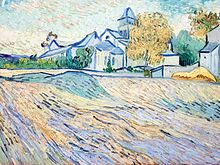아이펠 핫스팟
Eifel hotspot좌표: 50°12°N 화씨 6°42°E / 50.2°N 6.7°E

이 지도는 지구상의 화산 지대를 보여준다. Eifel 핫스팟은 8로 표시된다.
에이펠 핫스팟은 서독에 있는 화산 핫스팟이다. 이것은 에이펠 산맥과 그 주변에 있는 최근의 많은 화산 형성물들 중 하나이며 화산 에이펠로 알려진 화산 영역을 포함한다. 비록 마지막 폭발은 약 1만년 전에 일어났지만, 이 지역에서 화산 가스가 빠져나가는 것이 여전히 약하게 활동 중임을 나타낸다.
그 지역의 화산 활동의 기원에 관한 두 가지 경쟁적인 이론이 있다. 전통적인 견해는 그 지방이 맨틀 플룸에 의해 약화되어 있다는 것이다.[1][2] 플룸 원점에 대한 지원에는 딥망틀 선원을 나타내는 펫틸러, 지질화학 및 동위원소 증거,[3][2] 상부와 하부 맨틀의 지진 이상,[4][5][6][7] 부력 플룸을 암시하는 대규모 상승 및 확장의 측지학적 증거가 포함된다.[8]
최근 일부 과학자들은 전구체 상승, 시간 진행형 화산, 상부와 하부 맨틀의 지진 이상 간 연속성 등 맨틀 플럼과 관련된 특정 특성이 부족하다는 점을 강조해왔다. 따라서 그들은 대신 암석권과 지각 확장에 의한 수동적 용해와 알파인 오로지의 일부로서 유라시아 판의 지속적인 전도를 수반하는 얕은 대류 과정으로 구성된 지각적 기원을 주장해 왔다.[9][10][11]
참고 항목
참조
- ^ Ritter, J.R.R.; Jordan, M.; Christensen, U.R.; Achauer, U. (2001). "A mantle plume below the Eifel volcanic fields, Germany". Earth and Planetary Science Letters. 186 (1): 7–14. doi:10.1016/S0012-821X(01)00226-6.
- ^ a b Schmincke, H.U. (2007). "The Quaternary Volcanic Fields of the East and West Eifel (Germany)". In Ritter, J.R.R.; Christensen, U.R. (eds.). Mantle plumes – A multidisciplinary approach. Springer. pp. 241–322. doi:10.1007/978-3-540-68046-8_8. ISBN 978-3-540-68045-1.
- ^ Wedepohl, K.H.; Baumann, A. (1999). "Central European Cenozoic plume volcanism with OIB characteristics and indications of a lower mantle source". Contributions to Mineralogy and Petrology. 136 (3): 225–239. doi:10.1007/s004100050534. S2CID 128608750.
- ^ Walker, K.T.; Bokelmann, G.H.R.; Klemperer, S.L.; Bock, G. (2005). "Shear-wave splitting around the Eifel hotspot: Evidence for a mantle upwelling". Geophysical Journal International. 163 (3): 962–980. doi:10.1111/j.1365-246X.2005.02636.x.
- ^ Pilidoua, S.; Priestley, K.; Debayle, E.; Gudmundsson, O. (2005). "Rayleigh wave tomography in the North Atlantic: High resolution images of the Iceland, Azores and Eifel mantle plumes". Lithos. 79 (3–4): 453–474. doi:10.1016/j.lithos.2004.09.012.
- ^ Ritter, J.R.R. (2007). "The seismic signature of the Eifel plume". In Ritter, J.R.R.; Christensen, U.R. (eds.). Mantle plumes – A multidisciplinary approach. Springer. pp. 379–404. doi:10.1007/978-3-540-68046-8_12. ISBN 978-3-540-68045-1.
- ^ Zhao, D. (2007). "Seismic images under 60 hotspots: Search for mantle plumes". Gondwana Research. 12 (4): 335–355. doi:10.1016/j.gr.2007.03.001.
- ^ Corné Kreemer; Geoffrey Blewitt; Paul M. Davis. (2020). "Geodetic evidence for a buoyant mantle plume beneath the Eifel volcanic area, NW Europe". Geophysical Journal International. 222 (2): 1316–1332. doi:10.1093/gji/ggaa227.
- ^ Regenauer-Lieb, K. (1998). "Dilatant plasticity applied to Alpine collision: Ductile void growth in the intraplate area beneath the Eifel volcanic field". Journal of Geodynamics. 27 (1): 1–21. doi:10.1016/S0264-3707(97)00024-0.
- ^ King, S.D. (2007). "Hotspots and edge-driven convection". Geology. 35 (3): 223–226. doi:10.1130/G23291A.1.
- ^ Lustrino, M.; Carminati, E. (2007). "Phantom plumes in Europe and the circum-Mediterranean region". In Foulger, G.R.; Jurdy, D.M. (eds.). Plates, plumes, and planetary processes: Geological Society of America Special Paper 430. Geological Society of America. pp. 723–745. doi:10.1130/2007.2430(33). ISBN 9780813724300.


